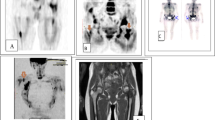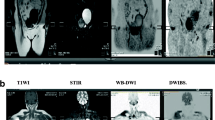Abstract
Objective
We evaluated (Whole-Body Diffusion Weighted Imaging, WB-DWI) application in bone metastasis.
Methods
WB-DWI with GE 1.5T MR/I was performed on 10 healthy volunteers and 35 patients. WB-DWI and ECT was performed in all 35 patients. Using WB-DWI for detecting bone metastasis and compared them with that of ECT.
Results
Background was suppressed in WB-DWI, fat, muscle, vessels and liver appeared same as background. Skeleton showed medium or slightly lower signal. Lymph nodes, some glandular organs, kidneys displayed medium signal. Spleen, testicle, brain tissue were low signal. Bladder, gallbladder were depicted as low signal because of “T2 through”. Bone metastasis were multitude and inequality of size, punctiform, nodosity, column low intensity. Concordance between WB-DWI and ECT was seen in 4 cases. WB-DWI displayed 1 bone metastasis on skull, 46 on rib and sternum, 3 on scapula, 4 on extremities, 83 on vertebral, 36 on pelvic bone. ECT showed 2 bone metastasis on skull, 62 on rib and sternum, 7 on scapula, 9 on extremities, 64 on vertebral, 19 on pelvic bone. WB-DWI was 74% for bone metastasis on rib and sternum, ECT was 77%, 53% for vertebral and pelvic bone. All of the focus were statistics analyses, P < 0.05. Total probability distribution inequality if metastasis on different positions.
Conclusion
WB-DWI was an effective imaging technology for screening bone metastasis.
Similar content being viewed by others
References
Takahara T, Imai Y, Yamashita T, et al. Diffusion weighted whole body imaging with background body signal suppression (DWIBS): technical improvement using free breathing, STIR and high resolution 3D display. Radiat Med, 2004, 22: 275–282.
Vilanova JC, Barceló J. Diffusion-weighted whole-body MR screening. Eur J Radiol, 2008, 67: 440–447.
Barceló J, Vilanova JC, Riera E, et al. Diffusion-weighted whole-body MRI (virtual PET) in screening for osseous metastases. Radiologia, 2007, 49: 407–415.
Mürtz P, Krautmacher C, Träber F, et al. Diffusion-weighted wholebody MR imaging with background body signal suppression: a feasibility study at 3.0 Tesla. Eur Radiol, 2007, 17: 3031–3037.
Bohlscheid A, Nuss D, Lieser S, et al. Tumor search with diffusion-weighted imaging. Rofo, 2008, 180: 302–309.
Li S, Sun F, Jin ZY, et al. Whole-body diffusion-weighted imaging: technical improvement and preliminary results. J Magn Reson Imaging, 2007, 26: 1139–1144.
Komori T, Narabayashi I, Matsumura K, et al. 2-[Fluorine-18]-fluoro-2-deoxy-D-glucose positron emission tomography/computed tomography versus whole-body diffusion-weighted MRI for detection of malignant lesions: initial experience. Ann Nucl Med, 2007, 21: 209–215.
Koh DM, Collins DJ. Diffusion-Weighted MRI in the body: applications and challenges in oncology. Am J Roentgenol, 2007, 188: 1622–1635.
Nakanishi K, Kobayashi M, Nakaguchi K, et al. Whole-body MRI for detecting metastatic bone tumor: diagnostic valu of diffusion-weighted images. Magn Reson Med Sci, 2007, 6: 147–155.
Lauenstein TC, Freudenberg LS, Goehde Sc, et al. Whole-Body MRI using a rolling table platform for the detection of bone metastases. Eur Radiol 2002, 12: 2091–2099.
Gao L, Liang BL, Zhang Y, et al. Diffusion-weighted imaging with background signal suppression in brachial plexus. Chin J Med Imaging Technol (Chinese), 2006, 22: 1756–1758.
Zhang Y, Liang BL, Gao L, et al. Clinical significance of diffusion-weigh MRI with STIR-EPI in differential diagnosis of cervical lymph nodes. Chin J Oncol (Chinese), 2007, 29: 70–73.
Xu BX, Guan ZW, Xu X, et al. Comparison between Efficiency of MR-Diffusion Weighted Imaging and Bone Scan Scintigraphy in Detection of Bone Metastasis. J Cap Med Univ, 2008, 29: 19–22.
Nakanishi K, Kobayashi M, Takahashi S, et al. Whole body MRI for detecting metastatic bone tumor: comparison with bone scintigrams. Magn Reson Med Sci, 2005, 4: 11–17.
Balliu E, Vilanova JC, Pelaez I, et al. Diagnostic value of apparent diffusion coefficients to differentiate benign from malignant vertebral bone marrow lesions. Eur J Radiol, 2008, 69: 560–566.
Author information
Authors and Affiliations
Corresponding author
Rights and permissions
About this article
Cite this article
Wu, X., Ma, C., Zhao, X. et al. Application of whole body diffusion weighted imaging in bone metastasis. Chin. -Ger. J. Clin. Oncol. 9, 44–47 (2010). https://doi.org/10.1007/s10330-009-0045-3
Received:
Revised:
Accepted:
Published:
Issue Date:
DOI: https://doi.org/10.1007/s10330-009-0045-3




